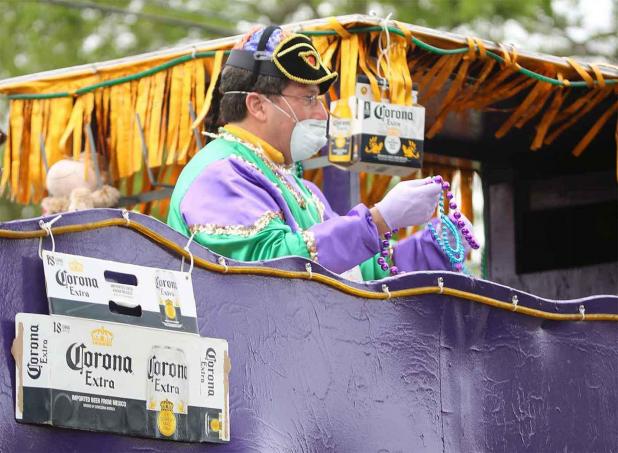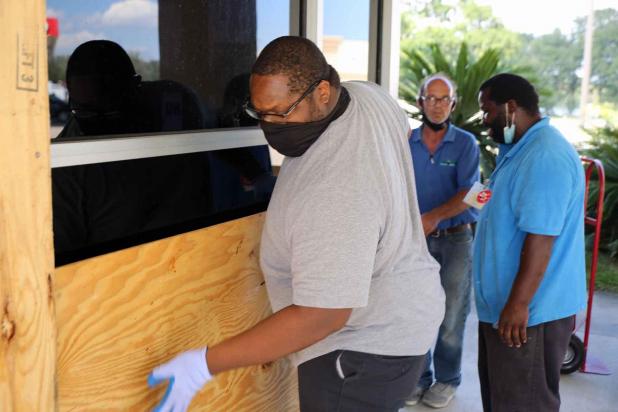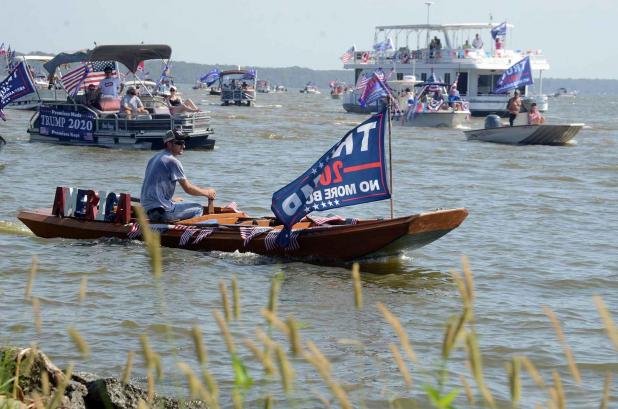
At Mardi Gras, the coronavirus was a far-off story, the sort of thing that makes a parade float theme. But within a month, COVID-19 became something much more serious.

Hurricane Delta's approach in early October meant it was time to break out the plywood. Here, workmen protect windows at the Hollywood Casino.

Supporters of President Donald Trump hold a boat rally on Lake Palourde.
At last, 2020 makes its exit after COVID and hurricanes
It's the last day of 2020. And who will miss it?
The year was dominated by a once-in-a-century pandemic and all the social, economic and political turmoil that ensued.
We did take time out to deal with hurricanes , a record number of which affected Louisiana.
And if you had any scrap left in you, there was always politics.
After Thursday, we can look forward to a happier and more prosperous new year. But for now, here's a look back at some of the events that made news stories in 2020.
A virus
goes global
Nobody now living could remember anything like it.
And the impact of COVID-19, with its rapid spread and its lethal potential, is likely to be felt for years.
As of Tuesday, more than 19 million confirmed cases and 337,000 deaths had been reported in the United States.
In St. Mary, St. Martin and Assumption parishes, where this newspaper circulates, more than 7,200 cases and 198 COVID-related deaths have been confirmed.
News accounts about the new virus began just before 2020 started and grew increasingly alarming until, on March 13, Gov. John Bel Edwards declared an emergency. His proclamation closed schools and non-essential businesses and included a stay-at-home order.
We were urged to wear masks, to avoid crowds, to wash our hands frequently and, in a new phrase we had to learn, to practice “social distancing."
There was another new phrase, too: “flatten the curve.” That meant we should take precautions in order to avoid overwhelming the health care system.
Louisiana saw a rapid rise in the number of COVID-positive people in hospitals early in the pandemic. That number would reach nearly 2,000 by early April.
The region’s biggest festival, Morgan City’s Louisiana Shrimp and Petroleum Festival, was canceled for 2020. Schools scrambled to set up virtual learning opportunities for students.
Nursing homes, with their populations of people most at risk from COVID-19, were hit especially hard. They included Legacy of Franklin, where 19 people died.
The mitigation measures seemed to work. After new cases statewide peaked at 1,335 in mid-March, the spread of the coronavirus slowed until, with cases averaging fewer than 500 a day in mid-May, Edwards moved Louisiana into less restrictive Phase 1 restrictions developed by the White House Coronavirus Task Force.
By early June, Edwards established even less restrictive Phase 2 rules.
Effective or not, there was push-back against mitigation measures.
In a speech for a St. Mary Chamber luncheon, Stephen Waguespack of the Louisiana Association of Business and Industry criticized what he called the “shutdown culture” that threatened to close many small businesses.
Bars were forced to close for much of the pandemic period, and a Morgan City man was among a group of Louisiana bar owners who went to court unsuccessfully to challenge Edwards’ order.
During a special legislative session in October, House Republicans invoked a little-used law in an attempt by petition to force Edwards to consult with the Legislature about public health emergencies.
So far, that effort has been unsuccessful, too.
But even Edwards has acknowledged that the mitigation measures come with a cost.
In St. Mary, which had struggled economically with a downturn in energy prices for more than five years before COVID, unemployment shot up to near 15% in the summer. That was despite millions coming into the parish in the form of a $600 weekly unemployment benefit enhancement and Paycheck Protection Program loans.
And then the second wave began.
Edwards imposed new measures that included a mask mandate after new daily COVID cases hit more than 2,600 in mid-July. By September, daily cases were below 700 again, and Edwards proclaimed that Louisiana was in Phase 3, the least restrictive level of mitigation measures.
But, once more, cases began to rise, peaking at nearly 3,800 daily before Edwards moved Louisiana back into a modified form of Phase 2 in early December.
Schools stayed open for on-campus learning, but the mask mandate remained in place, and stricter capacity limits on businesses and other public venues were imposed.
December also brought the first real ray of light in the pandemic: The arrival of the first shipments of COVID-19 vaccine. The Pfizer-BioNTech vaccine was directed at front-line health care workers, including those at Morgan City’s Ochsner St. Mary and Franklin Foundation Hospital.
Public health officials say they expect the vaccine supply will be sufficient to make inoculations available to the general public this spring.
Tropical season
for the books
The 2020 Atlantic hurricane season was the most active on record, and the epicenter was the Gulf Coast.
Thirty named storms — enough to use up the hurricane names for 2020 and force meteorologists to use Greek letters — included 13 hurricanes. Six of them reached the 111 mph threshold for major hurricanes.
For the first time, five hurricanes landed in Louisiana in a single season.
Cristobal, which hovered near hurricane strength but was mainly a tropical storm, formed June 1 and provided a grim hint of things to come when two Louisiana children were caught in a rip tide and drowned.
The worst of the storms were the devastating Laura, which reached Category 4 strength before making landfall Aug. 27, and Delta, a weaker but still powerful hurricane, which came ashore Oct. 9. Laura was reported to be the strongest hurricane to hit Louisiana since before the Civil War.
Only a few miles separated the points on the Cameron Parish coast where Laura and Delta came ashore six weeks apart. Delta struck portions of the southwest Louisiana coast, especially the Lake Charles area, where thousands of homes already had roofs patched with blue tarps.
Efforts to house the homeless were complicated by the COVID pandemic. Rather than rely on large, crowded shelters, the state government put up thousands of people in hotels where business had slumped because of the coronavirus.
Closer to home, homeland security officials made preparations for nine different storms. The biggest hurricane headaches in St. Mary were in the northwestern part of the parish due to coastal and canal flooding, which forced road closures.
Infrastructure improvements have some potential to prevent future flooding in that area.
The Yokeley Levee extension is designed to prevent flooding in the area near the Metal Shark and Gulf Craft shipbuilding facilities.
And the Bayou Teche Flood Control Project, which will use a swinging barge to block storm surge flooding from the Charenton Canal, is due for completion soon. The $11.4 million project is designed to prevent flooding in the Franklin, Garden City and Centerville areas.
The St. Mary Levee District used sheet piles to plug the gap where the barge was to be placed and got good results during Hurricane Delta.
Farther east, the Atchafalaya River generally behaved, staying below crest forecasts despite warnings of storm surges of 5 feet or more.
In the Tri-City area, the biggest problems were power outages, particularly during Delta, plus isolated instances of damage.
As they do every year, members of the Confraternity of Our Lady Star of the Sea made their way in June to the Spirit of Morgan City shrimp boat to pray for protection from hurricanes. So far, their prayers have been answered.
Electioneering
Politics had a big role to play in 2020.
At the national level, St. Mary was solidly behind President Donald Trump’s bid for re-election. Trump, a Republican, got 64% of St. Mary’s vote Nov. 3 to 35% for Democrat Joe Biden.
The parish went for two other Republicans seeking re-election to federal office: U.S. Sen. Bill Cassidy of Baton Rouge and U.S. Rep. Clay Higgins of Lafayette.
In Morgan City, businessman Lee Dragna won 56% of the Dec. 5 runoff vote to beat former Parish Councilman Kevin Voisin in the race to succeed Mayor Frank “Boo” Grizzaffi.
All five incumbent City Council members will return to office.
Tim Hymel, Steve Domangue and Mark Stephens qualified without opposition, and Lou Tamporello and Ron Bias won their races.
Longtime Assistant District Attorney Anthony “Tony” Saleme of Morgan City, who has prosecuted cases in St. Mary for the District Attorney’s Office, beat Iberia Parish Councilwoman Natalie Broussard for a seat on the 16th Judicial District bench.
Taxing
One of the most convoluted stories of the year involved an attempt by the St. Mary Parish School Board to seek a new half-cent sales tax for teacher and staff raises.
The board resolved in December 2019 to ask voters for the 0.5% tax, which would raise more than $4 million a year for raises and to feed a special technology fund. The raises would amount to $3,000 a year for certified employees and $1,500 a year for noncertified employees.
Board members said the raises were needed to attract and retain talented faculty members.
But opposition quickly developed among local officials, chiefly state Sen. Bret Allain, R-Franklin and chairman of the Senate Revenue and Fiscal Affairs Committee. Allain said he likes the idea of raising teacher pay but objected to the technology fund provision. And he questioned the timing of a new tax given the state of the parish’s economy.
The board reduced the size of the proposed tax to 0.45% and eliminated the technology fund language.
And, on the second try, the tax won approval for the ballot from the State Bond Commission.
But after seeing what they felt was inaccurate ballot language from the Secretary of State’s Office, board members withdrew the tax from consideration.
The School Board recently voted to put a 0.45% sales tax measure with no technology fund dedication on the March 20 parishwide ballot.
Draining
A move to streamline taxing districts in St. Mary Parish kicked up a controversy that lasted most of the year.
The St. Mary Parish Council voted in April to merge two gravity drainage districts: District No. 2 in the Morgan City area and No. 6 serving Amelia. The merger creates Gravity Drainage District 2A.
The most visible advocate has been Parish President David Hanagriff, who said the merger would reduce administrative overhead and create a stronger single district. He said money raised in Morgan City would be used for work in Morgan City, and the same goes for Amelia.
Opponents, including Parish Council Chairman Dean Adams, argued that one district or the other would inevitably lose in the deal.
The consolidation has suffered a couple of recent setbacks.
On Dec. 5, a proposition to combine the property tax levies from the two original districts into a single millage of up to 7.3 mills failed by a nearly 2-to-1 margin.
Then, on Dec. 16, Lee Dragna came to the council to challenge the original consolidation vote.
Dragna had served as board chairman of District 2 before the merger.
Accompanied by an attorney, Dragna said that at the April meeting, the council had voted to cut off debate without the super majority required by Roberts Rules of Order. And that, Dragna said, should invalidate the subsequent vote to consolidate the districts.
Hanagriff responded only that he disagreed but wouldn’t say more because of the legal issues involved.
A new NERR?
Late in the year, St. Mary Excel, the citizens group that commissioned the Urban Land Institute study of Berwick and Morgan City, got behind the idea of a National Estuarine Research Reserve.
The reserves, which dot the Gulf Coast everywhere except in Louisiana, are part of a program at the National Oceanic and Atmospheric Administration.
NOAA and the states designate areas near the places where rivers meet salt water for education, research and tourism.
The reserves may be on public or private land or some combination.
The federal government pays 70% of the operational expenses, and the state pays the remainder. State land use rules continue to apply.
The lower Atchafalaya is one of six broad areas under consideration for such a research.
The Morgan City Council resolved earlier this month to support a National Estuarine Research Reserve, known as a NERR, in this region.
The site selection process will continue in 2021.
